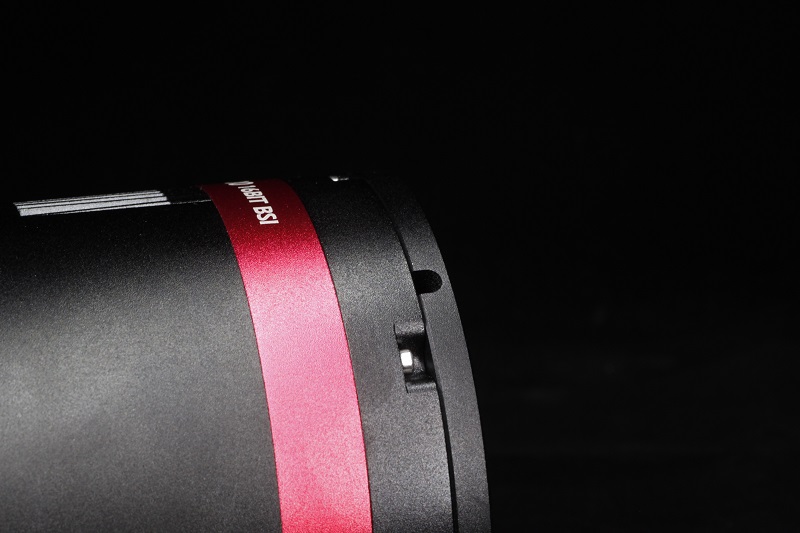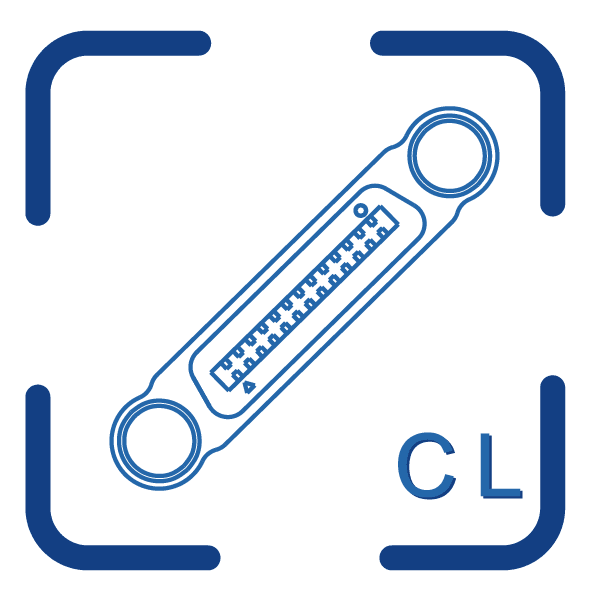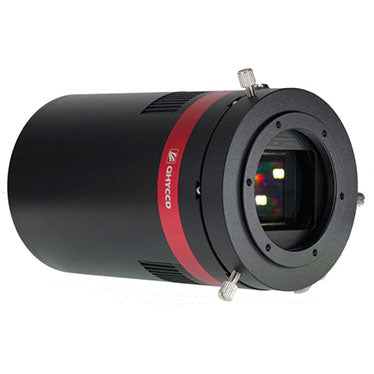QHY600PRO
QHY600PRO
Couldn't load pickup availability
The QHY600 Pro is a remarkable full-frame sensor CMOS camera designed for astrophotography. Let’s explore its features:
-
Sensor and Resolution:
- The QHY600 Pro uses the Sony IMX455 BSI sensor, available in both monochrome (QHY600PH-M) and color (QHY600PH-C) versions.
- This full-frame (35mm format) sensor boasts an impressive 60 megapixels with a pixel size of 3.76μm.
- The native 16-bit A/D conversion ensures high sample resolution and low system gain, resulting in accurate data acquisition.
-
BSI Technology:
- The back-illuminated (BSI) structure of the IMX455 sensor improves its full well capacity.
- In the back-illuminated sensor, light enters the photosensitive surface from the reverse side, allowing more photons to strike the photosensitive layer.
- This results in higher quantum efficiency, making the sensor more sensitive to capturing dim objects in the night sky.
-
Low Noise and High Sensitivity:
- The QHY600 Pro achieves extremely low dark current (only 0.002e-/pixel/sec at -20°C) using Sony’s Exmor BSI CMOS technology.
- It exhibits zero amplifier glow and has only one electron of read noise at high gain and full resolution, allowing it to achieve a signal-to-noise ratio (SNR) greater than 3 with just 4 to 6 photons.
- These features make it ideal for sky surveys, time domain astronomy, fluorescence imaging, DNA sequencing, and microscopy.
-
Image Buffer:
- To ensure smooth uninterrupted data transfer of the entire 60MP sensor at high speed, the QHY600 Pro (except QHY600M-PH L) has a 2GB DDR3 image buffer.
- The large buffer meets the needs of high-speed image acquisition and transmission, reducing pressure on the computer CPU.
-
Liquid Cooling and Other Variants:
- The QHY600 Pro also includes variants such as:
- QHY600PH-M SBFL (short back focal length)
- QHY600PH-C SBFL
- QHY600PH-M LQ (supports liquid cooling)
- The QHY600 Pro also includes variants such as:
In summary, the QHY600 Pro combines high resolution, low noise, and efficient cooling, making it an excellent choice for serious astrophotographers and scientific researchers123. You can find more information about this camera on the QHYCCD website.

QHY600Pro has a Short Back Focal Length version (QHY600SBFL) is specially designed for DSLR lens users or those who has special requirement of short back focal length. This version has a special f has 14mm B.F.L only. Furthermore, the B.F.L equals 12.5mm when connecting QHYCFW with the adapter. It can easily match Canon/Nikon lens even with filter wheel.


 Native 16 bit A/D: The new Sony sensor has native 16-bit A/D on-chip. The output is real 16-bits with 65536 levels. Compared to 12-bit and 14-bit A/D, a 16-bit A/D yields higher sample resolution and the system gain will be less than 1e-/ADU with no sample error noise and very low read noise.
Native 16 bit A/D: The new Sony sensor has native 16-bit A/D on-chip. The output is real 16-bits with 65536 levels. Compared to 12-bit and 14-bit A/D, a 16-bit A/D yields higher sample resolution and the system gain will be less than 1e-/ADU with no sample error noise and very low read noise.
 BSI: One benefit of the back-illuminated CMOS structure is improved full well capacity. This is particularly helpful for sensors with small pixels. In a typical front-illuminated sensor, photons from the target entering the photosensitive layer of the sensor must first pass through the metal wiring that is embedded just above the photosensitive layer. The wiring structure reflects some of the photons and reduces the efficiency of the sensor. In the back- illuminated sensor the light is allowed to enter the photosensitive surface from the reverse side. In this case the sensor’s embedded wiring structure is below the photosensitive layer. As a result, more incoming photons strike the photosensitive layer, and more electrons are generated and captured in the pixel well. This ratio of photon to electron production is called quantum efficiency. The higher the quantum efficiency the more efficient the sensor is at converting photons to electrons and hence the more sensitive the sensor is to capturing an image of something dim.
BSI: One benefit of the back-illuminated CMOS structure is improved full well capacity. This is particularly helpful for sensors with small pixels. In a typical front-illuminated sensor, photons from the target entering the photosensitive layer of the sensor must first pass through the metal wiring that is embedded just above the photosensitive layer. The wiring structure reflects some of the photons and reduces the efficiency of the sensor. In the back- illuminated sensor the light is allowed to enter the photosensitive surface from the reverse side. In this case the sensor’s embedded wiring structure is below the photosensitive layer. As a result, more incoming photons strike the photosensitive layer, and more electrons are generated and captured in the pixel well. This ratio of photon to electron production is called quantum efficiency. The higher the quantum efficiency the more efficient the sensor is at converting photons to electrons and hence the more sensitive the sensor is to capturing an image of something dim.
Anti-Dew Technology: Based on almost 20-year cooled camera design experience, The QHY cooled camera has implemented the fully dew control solutions. The optic window has built-in dew heater and the chamber is protected from internal humidity condensation. An electric heating board for the chamber window can prevent the formation of dew and the sensor itself is kept dry with our silicon gel tube socket design for control of humidity within the sensor chamber.
 Cooling: In addition to dual stage TE cooling, QHYCCD implements proprietary technology in hardware to control the dark current noise.
Cooling: In addition to dual stage TE cooling, QHYCCD implements proprietary technology in hardware to control the dark current noise.
 The 2*10Gigabit Fiber Optic Interface (to be used with QHYCCD fiber optic capture card) meets the high-intensity data transmission requirements of professional fields such as professional observatories. It has the following advantages over the USB 3.0 interface:
The 2*10Gigabit Fiber Optic Interface (to be used with QHYCCD fiber optic capture card) meets the high-intensity data transmission requirements of professional fields such as professional observatories. It has the following advantages over the USB 3.0 interface:
Higher data rates
Using two 10G fiber optics, it can achieve a speed of 1.6GBytes/s, while the standard USB 3.0 has a rate of 5Gbps, with an actual maximum transfer rate of 350MBytes/s.
Longer transmission distance
Fiber optic transmission can cover distances hundreds of times longer than USB 3.0. Standard USB 3.0 can only transmit up to 3 to 5 meters, and even with an active powered USB cable, it can reach up to 10 to 15 meters. In contrast, QHYCCD’s standard fiber optic module can achieve a transmission distance of up to 300 meters, and when paired with long-distance transmission optical modules, it can cover distances of several tens of kilometers.
Stable transmission without electromagnetic interference
USB 3.0 transmission can be susceptible to external electromagnetic interference, static electricity, leakage, and other factors, leading to data packet corruption, image loss, or camera control issues. Optical communication is not affected by electromagnetic interference.
 Supports the professional Camera Link interface (exclusive to Pro II products)
Supports the professional Camera Link interface (exclusive to Pro II products)
The Camera Link interface is a more suitable choice if your use case involves shorter transmission distances in industrial or laboratory areas. The Camera Link interface is specifically designed for high-speed and high-resolution cameras, offering fast data transmission speeds. It is well-suited for working under conditions where there is a large amount of image data and high bandwidth requirements.
 This product supports custom water cooling. If you have water cooling customization requirements, please contact the QHYCCD sales department.
This product supports custom water cooling. If you have water cooling customization requirements, please contact the QHYCCD sales department.
Compared to air cooling, water cooling offers the following advantages:
More efficient cooling. When using ambient temperature pure water for water cooling, the maximum cooling temperature is about 10 degrees Celsius lower than that of air cooling. QHYCCD is improving its support for ultra-low temperature liquid cooling.
No vibration. No matter how high-quality the fan is, it is inevitable to generate some image jitter. The water-cooling version does not have moving mechanical parts that cause camera vibration, thus avoiding negative effects on the image.
No turbulent hot air. For certain cameras that need to be installed in front of the optical system, such as Schmidt-Cassegrain telescopes, the hot air generated by air cooling systems may cause slight interference with the optical path. Water cooling does not produce this kind of impact.
Multiple Readout Modes are special for QHY 16-bit Cameras (QHY600/268/461/411). Different readout modes have different driver timing, etc., and result in different performance. See details at “Multiple Readout Modes and Curves” Part.
You may find some types of thermal noise can change with time in some back-illuminated CMOS cameras. This thermal noise has the characteristic of the fixed position of typical thermal noise, but the value is not related to the exposure time. Instead, each frame appears to have its own characteristics. The QHY600/268/461/411 use an innovative suppression technology that can significantly reduce the apparent level of such noise.
UVLO Protection
UVLO(Under Voltage Locking) is to protect the electronic device from damage caused by abnormally low voltages.
Our daily life experience tells us that the actual operational voltage of an electrical device must not significantly exceed the rated voltage, otherwise it will be damaged. For such precision equipment as cameras, long-term work at too low input voltage can also be detrimental to the working life of the camera, and may even make some devices, such as power manager, burn up due to long-term overload. In the all-in-one driver and SDK after 2021.10.23 stable version, the camera will give a warning when the input voltage of the camera is below 11V.
It is common behavior for a CMOS sensor to contain some horizontal banding. Normally, random horizontal banding can be removed with multiple frame stacking so it does not affect the final image. However, periodic horizontal banding is not removed with stacking so it may appear in the final image. By adjust the USB traffic in Single Frame mode or Live Frame mode, you can adjust the frequency of the CMOS sensor driver and it can optimize the horizontal banding appeared on the image. This optimized is very effective to remove the periodic banding in some conditions.
A typical Periodic Horizontal Noise under certain USB_TRAFFIC values.
After Adjusting the USB Traffic to avoid the periodic horizontal noise.
The camera is designed to use the +12V to reboot the camera without disconnecting and reconnecting the USB interface. This means that you can reboot the camera simply by shutting down the +12V and then powering it back on. This feature is very handy for remote controlling the camera in an observatory. You can use a remotely controlled power supply to reboot the camera. There is no need to consider how to reconnect the USB in the case of remote control.
| Model |
QHY600Pro I QHY600Pro II |
| CMOS Sensor | SONY IMX455 BSI CMOS Sensor |
| Mono/Color | Both Available |
| Pixel Size | 3.76um |
| Effective Pixel Area | 9576*6388(9600*6422 with overscan and optically black area) |
| Number of Effective Pixels | 61.17MP |
| Sensor Size | Full Frame (36mm*24mm) |
| A/D Sample Depth |
Native 16-bit (0-65535 greyscale) A/D 18-bit at 2X2, 19-bit at 3X3, 20-bit at 4X4 software binning*QHY600 uses the software digital binning for 2*2binning. With digital sum, 2*2binning will be four 16-bit summed then it is 18-bit. |
| Full Well Capacity (1×1, 2×2, 3×3) |
Photographic Mode >51ke- / >204ke- / >408ke- Extended Full Well Mode >80ke- / >320ke- / >720ke- |
| Full Resolution Frame Rate (USB3.0 Port) |
4.0FPS@8BIT 2.5FPS@16BIT |
| ROI Frame Rate (USB3.0 Port) |
2048lines, 12FPS@8BIT, 7.5FPS@16BIT 1080lines, 22.5FPS@8BIT, 14FPS@16BIT 768lines, 31.5FPS@8BIT, 19.5FPS@16BIT 480lines, 47FPS@8BIT, 30FPS@16BIT |
| Readout Noise |
Photography DSO Mode:1.9e- to 7.8e-(Gain0-100) High Gain Mode:1.1e- to 3.6e-(Gain0-100) Extend Fullwell Mode:5.4e- to 7.9e-(Gain0-100) Extend Fullwell Mode-2CMS:4.9e- to 5.9e-(Gain0-100) |
| Dark Current |
0.0022e-/p/s @ -20℃ 0.0046e-/p/s @ -10℃ |
| Exposure Time Range | 40us – 3600sec |
| Amp Control | Zero Amplifer Glow |
| Shutter Type | Electric Rolling Shutter |
| Computer Interface |
1*USB3.0 Interface 2*10Gigabit Fiber Interfaces 2*CameraLink Interfaces (Pro II Version Only) |
| Built-in Image Buffer | 2GB DDR3 Memory Buffer |
| Air Cooling System |
Dual Stage TEC cooler: – Long exposures (> 1 second) typically -35C below ambient – Short exposure (< 1second) high FPS, typically -30C below ambient(Test temperature +20°) |
| Optic Window Type | AR+AR High Quality Multi-Layer Anti-Reflection Coating |
| Anti-Dew Heater | Yes |
| Telescope/Lenses Interface | Support 2-inch, M54, M48, Nikon/Canon DSLR Lens, etc. (Combined with adapters ) |
| Filter Wheel Interface | 4PIN QHYCCD CFW Port |
| Back Focal Length | 17.5mm (±0.2) |
| Recommended Gain Setting |
25 (Unity Gain, Extended Full Well Mode/Photographic Mode) 56 (High Gain Mode) |
| Weigth | About 1000g |
| Firmware/FPGA remote Upgrade | Supported. Via Camera USB Port |
| Water Cooling Version (Optional) | -45℃ below ambient with water in long exposures; up to -60℃ below ambient with cold liquid; Recommended flow rate for water-cooled versions is 1.6ml/s. |
| Power |
40W/100% 20W/50% 13.8W/0% |
Share





